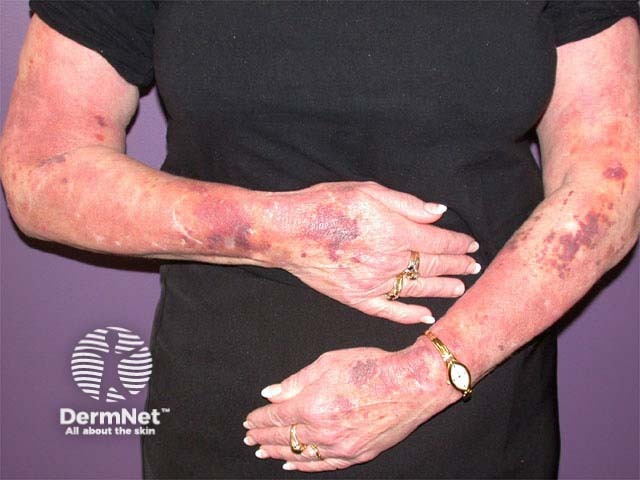Main menu
Common skin conditions

NEWS
Join DermNet PRO
Read more
Quick links
Mixed diagnoses – 10 cases (4 of 11)
For each of the ten cases, study the image(s) and then answer the questions. You can click on the image to view a larger version if required.
Each case should take approximately five minutes to complete. There is a list of suggested further reading material at the end of the quiz.
When you finish the quiz, you can download a certificate.
Case 1

What medication is she applying to the affected areas?
She has been applying potent or ultrapotent topical steroids for months or years (in this case, betamethasone valerate). Signs of steroid atrophy may include skin transparency, striae, telangiectasia, skin fragility & jagged scars. Senile or 'solar' purpura arises because red cells leak into the dermis after rubbing a persistent pruritic dermatosis (in her case, atopic dermatitis). It is especially likely on sun-exposed sites, already thinned by ultraviolet radiation.
Which related medication(s) may also cause 'senile' purpura?
Systemic and high dose inhaled corticosteroids may also result in cutaneous atrophy and purpura, characteristic signs of Cushing's syndrome.
What investigations would you arrange?
No investigations are necessary if the clinical diagnosis is obvious. If there is doubt, consider thrombocytopenia or other haematological reason for bleeding, as these may be disastrous.
How would you treat this problem?
If possible, discontinue topical steroids. Do this slowly to reduce the chance of rebound flare of dermatitis. Gradually select less potent products and apply less frequency, using emollients to calm itching. Ask a dermatologist for advice. Protect affected areas from the sun with clothing and sunscreens. Try not to scratch or otherwise injure the skin. It is not known if any other measures help but tretinoin, calcipotriol and oral or topical vitamin C have been recommended.
